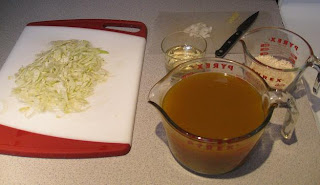 Ingredients:
Ingredients:1 Fennel Bulb
1/4 Onion
1 or 2 Cloves of Garlic
1 T Olive Oil
1/2 Cup Arborio Rice
2 T White Wine
4 Cups Broth
Black Pepper and Parmesan to taste

STEP 1 - Cut the fronds and base from the bulb. Quarter, and slice off the tough core at the bottom of the bulb. Chop into thin slices.
If you taste a piece of fennel you will notice that it has a strong licorice flavor. This made me a little nervous at first, but I discovered that the flavor mellows significantly when cooked.
STEP 2 - Heat the broth to not-quite-boiling. The traditional way is to use two pots on two burners, one for the broth and one for the rice. What I do is heat the broth in a Pyrex measuring cup in the microwave.
You won't use all 4 cups of the broth, but it's better to have too much than not enough. Also be aware that the broth will be a very prominent flavor in the final product, so be sure you use a broth you like.

STEP 3 - Dice a quarter onion and press a clove or two of garlic. Saute in a saucepan with a tablespoon of olive oil for a few minutes until the onion is clear. Add the fennel and saute a few minutes more until it's soft. Finally, add the arborio and stir it in until it's coated.
Arborio is a special type of starchy rice. It can be found in any grocery store. It's important to use this type and not substitute with "regular" rice.

STEP 4 - Pour in about 2 tablespoons of white wine. This picture is misleading, I'm not pouring the whole glass of wine in. I'm only splashing in a tablespoon or two - I'm drinking the rest.
STEP 5 - If your using the traditional two pot method, ladle a cup or so of hot broth on to the rice and stir constantly. If you're using the microwave method, pour a cup of hot broth from the Pyrex.

Keep stirring until the liquid evaporates and the mixture starts to thicken (about 4 minutes). Add more hot broth and continue stirring. Keep adding hot broth a half cup at a time every few minutes as the mixture thickens. You may need to put the Pyrex back in the microwave a few times to make sure the broth stays almost boiling.

After about 16 minutes or so, the rice will start to release its starch and the broth will begin to get creamy. At this point, take a small bite of the rice to see if it's "al dente". If not, add more broth, stir until thick, and taste again. Repeat this as often as necessary. I find the whole process usually takes a total 22-24 minutes from when I first add the broth.
Keep in mind that the risotto continues to cook a little after it's removed from the heat, so remove it from the heat just a bit before. Also, it thickens as it cools, so be sure that it's just a little bit too saucey when you finish.
Once done, add salt and pepper to taste. Lots of risotto recipes say to stir in cheese or cream at this point. I find the risotto creamy enough as is, so I just add a little parmesan on top.

 Ingredients:
Ingredients: STEP 1 - Remove the stems from the greens; the easiest way to do this is fold the leaf in half first. Both the stems and the greens are edible, but they need to be cooked separately.
STEP 1 - Remove the stems from the greens; the easiest way to do this is fold the leaf in half first. Both the stems and the greens are edible, but they need to be cooked separately. STEP 2 - Cut the stems into lengths about an inch and a half long. Boil them in salty water (a tablespoon or two of salt in two or three cups of water - don't worry, you won't be eating this much salt) for about 3-5 minutes. Strain and Rinse thoroughly to remove the salt water.
STEP 2 - Cut the stems into lengths about an inch and a half long. Boil them in salty water (a tablespoon or two of salt in two or three cups of water - don't worry, you won't be eating this much salt) for about 3-5 minutes. Strain and Rinse thoroughly to remove the salt water. STEP 3 - Coarsely chop greens crosswise into strips about 3/4 inch wide. Blanch and Shock: Submerse in boiling water (no salt this time) for about 30 seconds then immediately strain and rinse with very cold water to stop the cooking.
STEP 3 - Coarsely chop greens crosswise into strips about 3/4 inch wide. Blanch and Shock: Submerse in boiling water (no salt this time) for about 30 seconds then immediately strain and rinse with very cold water to stop the cooking. STEP 4 - In a skillet on medium heat, heat olive oil, red wine vinegar, and soy sauce. Add sesame seeds and fry them for half a minute or so. Then add stems and saute them for a couple minutes until they're cooked through. Turn off the heat and add the greens. Stir them until they've heated up.
STEP 4 - In a skillet on medium heat, heat olive oil, red wine vinegar, and soy sauce. Add sesame seeds and fry them for half a minute or so. Then add stems and saute them for a couple minutes until they're cooked through. Turn off the heat and add the greens. Stir them until they've heated up.















